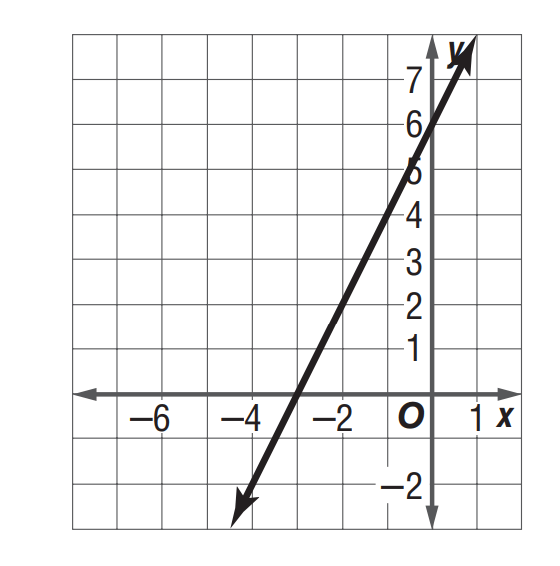Describe x-intercept and y-intercept.
The x intercept is the point where the line crosses the x axis. At this point y = 0.
The y intercept is the point where the line crosses the y axis. At this point x=0
Write a linear function with a slope of -9 and a y-intercept of 5
y =-9x+5
Identify the slope of the linear equation
y = -x + 6
The slope is -1
What happened to the slopes when the two lines are parallel to each other?
What happened to the slopes when the two lines are perpendicular to each other?
If two nonvertical lines have the same slope, then they are parallel.
If the product of the slopes of two nonvertical lines is -1, then the lines are perpendicular.
Function or not?
(-2,3), (-1,3), (8,4), (11,2)
yes
What is Zeros?
Values of x for which f(x) = 0 are called zeros of the function f. The zero of a function is its x-intercept.
Write an equation for a line that passes through (-9, 8) with slope -6 in Point-Slope form.
y-8=-6(x+9)
Find the slope
2
What is the slope of the line if it's parallel to 9x-4y=12?
What is the slope of the line if it's perpendicular to 9x-4y=12?
m1=9/4
parallel: m2=9/4
perpendicular: m3=-4/9
What is F(22)+6 if F(x) = -3x + 10?
-50
What is Direct variation?
A direct variation is described by an equation of the form y = kx, where k ≠ 0. The equation y = kx represents a constant rate of change and k is the constant of variation.
Rewrite the slope-point form y+7=-3(x-2) into slope-intercept form. Then to standard form.
slope-intercept form: y= -3x - 1
standard form: 3x+y=-1
Find the slope:
(-8,2) (13,-5)
m=(2-(-5))/(-8-13)=-7/21=-1/3
Write the slope-intercept form of an equation of the line that is parallel to y = 2 and passes through (5, -2)
y=-2
f(x)=x^3+x^2+x
Evaluate function value f(2)-10
8+4+2-10=4
What are the three forms of a line?
y=mx+b
Ax+By=C
y-y1=m(x-x1)
Which of the following equations do NOT represent linear functions?
A. 12 = 2x2 + 4y2 D. x = 9 - 3/4y
B. y = x + 3 E. y = 5x/11
C. 2x + y = 8 F. xy = 9
A, F
Find the slope:
3y+7x=19
m=-A/B=-7/3
Write the slope-intercept form of an equation for the line that passes through (-3, -2) and is parallel to the graph of 4x + y = 12.
m1=-4, since parallel, so m2=-4
y=-4x+b, substitute x=-3, y=-2
-2=-4x(-3)+b, we get b=-14
y=-4x-14
Arithmetic Sequences: 6, 11, 16, 21......
What is the 100th term?
nth term: an=a1+(n-1)d
an= 6+(n-1)x5
a100=6+(100-1)x5=6+99x5=501
Define a linear function.
A function whose graph is a nonvertical line and has a constant rate of change
Determine the x-intercept, y-intercept, and zero of the function 9x-5y=76
x-intercept: (76/9, 0)
y-intercept: (0, -76/5)
zero: 76/9
Write the point-slope form of an equation of the line that passes through (2, 8) and (10, -3)
m=(8-(-3))/(2-10)=11/-8=-11/8
y-8=-11/8(x-2)
OR y+3=-11/8(x-10)
Write the slope-intercept form of an equation for the line that passes through (-4, -2) and is perpendicular to the graph of 4x + y = 12.
m1=-4, since perpendicular, so m2=1/4
y=1/4x+b,
substitute x=-4, y=-2
-2=1/4(-4)+b
b=-1
y=1/4x-1
The migration of snow geese varies directly as the number of hours. A flock of snow geese migrated 375 miles in 7.5 hours.
a)Write a direct variation equation for the distance d flown in time t.
b)Estimate how many hours of flying time it would take the geese to migrate 3000 miles.
y=kx, substitue y=375 and x=7.5
375=7.5k, we get k=50
a)y=50x
b)3000=50x, we get x=60